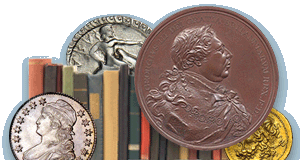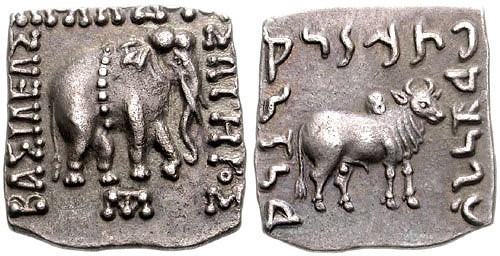
PREV ARTICLE
NEXT ARTICLE
FULL ISSUE
PREV FULL ISSUE
NGC ANCIENTS: ELEPHANTSNGC has published an article on elephants depicted on Greek, Carthaginian and Roman coins in conjunction with World Elephant Day on August 12. -Garrett World Elephant Day is celebrated August 12 to bring attention to the plight of elephants. All three of the world's elephant species — the African bush elephant, the African forest elephant and the Asian elephant — are endangered. Elephants have always been well-known for their strength and grace, but in ancient times they also were prized for their value in battle. Various Greek, Roman and Carthaginian coins feature elephants, with the following being excellent examples. Following Alexander's death at the age of 32, his kingdom was divided among his lieutenants. This gold stater was struck under one of Alexander's generals, Ptolemy I (323-282 B.C.), founder of the Ptolemaic Kingdom based in Egypt. The reverse shows a chariot drawn by elephants.
Another one of Alexander's generals, Seleucus I (312-281 B.C.), founded the Seleucid Kingdom, which stretched from the Aegean Sea to India. This silver tetradrachm, struck late in his reign, shows a chariot of four elephants fancifully adorned with horns, as well as tusks. An Indian ally provided Seleucus with hundreds of war elephants and riders, which were of great value in the Battle of Ipsus in 301 B.C. This silver square drachm struck for the Bactrian king Apollodotus I (c.180-160 B.C.) shows an elephant wearing a belt and a bull. The inscription on the obverse is Greek and on the reverse is Kharosthi, an ancient Indian script. This base-metal coin was issued for the Bactrian king Menander I (c.165-130 B.C.). It shows the head of elephant adorned with a bell, opposite the club of Heracles. Menander ruled an area that included much of modern-day Pakistan and was a patron of Greco-Buddhism. Rome's victory over Carthage in the Second and Third Punic Wars allowed it to dominate most of the Mediterranean by the time this silver denarius was struck in 125 B.C. Issued by C. Caecilius Metellus Caprarius, it shows Roma on the obverse and Victory crowning Jupiter, who drives a biga of elephants on the reverse. The most famous of all ‘elephant' coins is the silver denarius of Julius Caesar (died 44 B.C.), which he issued in 49 or 48 B.C. at a military mint traveling with him. At the time, Caesar had just begun Caesar's civil war, in which he fought his rival, Pompey. This base-metal coin was issued ca. 60-46 B.C. by Juba I, king of the North African kingdom of Numidia, who fought on the Pompeian side during the civil war. Juba and Metellus Pius Scipio opposed Julius Caesar in North Africa but were on the losing side of the Battle of Thapsus in 46 B.C., the last large-scale use of war elephants in the West. Seeing their cause as hopeless, Juba and Metellus Scipio are both recorded as choosing honorable deaths a short time later. This billon tetradrachm struck in Egypt late in the reign of Emperor Nero (A.D. 54-68) shows a draped bust of a woman, representing the city of Alexandria, wearing an elephant headdress. This base-metal sestertius produced soon after the death of Emperor Vespasian (A.D. 69-79) in A.D. 79 offers him a dignified send-off. It shows the deified emperor holding Victory while being drawn by a quadriga of elephants with riders. Vespasian's son and successor, the emperor Titus (A.D. 79-81), issued this gold aureus in A.D. 80, shortly after becoming emperor. The size and shape of the tusks appear to identify the elephant here as an African one. This base-metal "as" coin issued under Emperor Antoninus Pius (A.D. 138-161) shows an elephant. It is inscribed MVNIFICENTIA AVG COS III and was issued in celebration of games held for Rome's 900th anniversary. This billon nummus issued at the mint of Carthage for the rebel-emperor Maxentius (A.D. 307-312) shows the personification of Africa. The figure wears an elephant headdress and holds a tusk. The ivory of elephant tusks was highly valued in Roman times, and its attraction long outlasted antiquity. International ivory trade was finally banned in 1989 in an effort to prevent elephants from going extinct. Who knew there was a "World Elephants Day"? Not me, and my wife collects elephants. I've added it to my calendar. -Editor
To read the complete article, see:
Wayne Homren, Editor The Numismatic Bibliomania Society is a non-profit organization promoting numismatic literature. See our web site at coinbooks.org. To submit items for publication in The E-Sylum, write to the Editor at this address: whomren@gmail.com To subscribe go to: Subscribe All Rights Reserved. NBS Home Page Contact the NBS webmaster 
|











